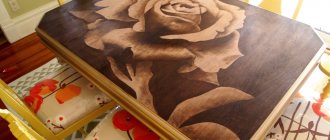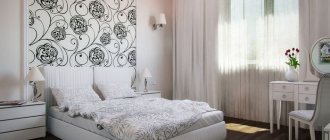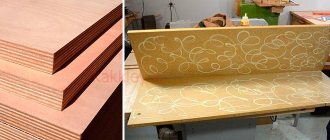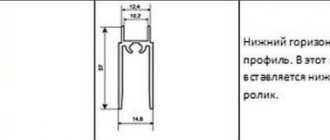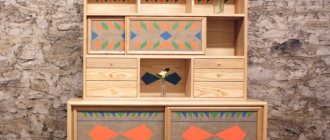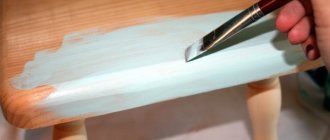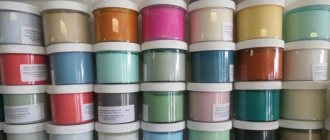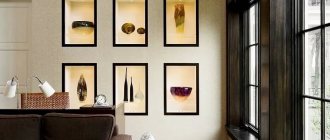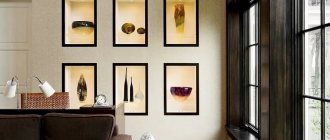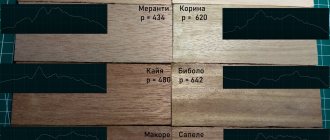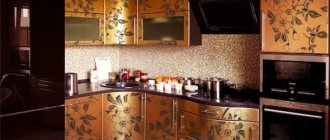How to bend wood
If you decide to decorate the room with wood or start creating beautiful furniture in a classic style, then you will need to make curved parts. Fortunately, wood is a unique substance because it allows an experienced craftsman to play with the form a little. It's not as difficult as it seems, but not as easy as we would like.
Previously, the site already had a publication on bending plywood. In this article we will understand the principles of bending solid boards and timber, and find out how this is done in production. We will also provide useful tips from professionals that will be useful to the home craftsman.
Selection of accessories
The construction market now offers a huge range of fittings for radius fittings, including hinges. From a technical point of view, hinges can be divided into those with and without a closer. A closer is a special mechanism with which doors close smoothly and door slams are eliminated.
There are also loops for:
- overhead doors - they cover the ends of the side walls of the frame;
- adjacent doors - when used, the facade covers the edge of the side of the cabinet by half;
- inset doors - used when the depth of the door does not protrude beyond the cabinet frame.
For corner cabinets, you should take a closer look at crab hinges. The best fittings are made by German.
Why bending is better than sawing
A curved wooden part can be obtained by two methods: by bending a flat piece, or by cutting out the required spatial shape. The so-called “sawing” method attracts users with its simplicity. For such production of parts and structures, you do not need to use complex devices, you do not have to spend a lot of time and effort. However, in order to cut a curved wooden product, you have to use a workpiece that is obviously too large, and a lot of valuable material will be irretrievably lost as waste.
But the main problem is the performance characteristics of the resulting parts. When cutting a curved part from ordinary edged lumber, the wood fibers do not change their direction. As a result, transverse cuts fall into the radius zone, which not only worsen the appearance, but also significantly complicate the subsequent finishing of the product, for example, its milling or fine grinding. In addition, in the rounded areas that are most vulnerable to mechanical stress, the fibers run across the section, which makes the part prone to fracture in this place.
Whereas when bending, the opposite picture is usually observed, when the wood only becomes stronger. The edges of the curved beams or boards do not have “end” cuts of fibers, so subsequently such workpieces can be processed without restrictions, using all standard operations.
Bending wood fibers
Advantages and disadvantages
Such an original set always attracts more attention than a regular one. Moreover, the smallest imperfections and defects of the room remain unnoticeable: uneven walls, defects in the floor covering and the geometry of the room are smoothed out.
There are many advantages of curved facades:
- beauty and aesthetics. Often, only this factor influences the choice of owners, since it plays a very important role. To many, smooth and oval shapes themselves seem much more attractive than constant right angles;
- reliability ensured by good stability. There is no need for reinforcement or installation of any stiffening ribs, so the manufacturing process is not so difficult;
- safety. The owners will long rejoice at the absence of sharp corners when small children appear;
- increased capacity. If we compare the capacity of the same size standard headset with a radius one, the latter will win;
- increased workplace due to radial protrusions;
- zoning. Concave and convex elements can very successfully divide the space into different functional zones;
- wide range of both design and color;
- Possibility of installation in small and large kitchens.
The disadvantages of radius facades are not so numerous:
- appearance. Still, not everyone likes such extravagant furniture;
- price. The production of bent panels is more complicated, the waste of material is greater, and engineering calculations are more complicated - all this is reflected in the cost;
- deadlines. Such a set is often made to order, which is reflected in the waiting time for furniture;
- if the room does not have a large area, for example, in a Khrushchev-era building, then the set may not look as impressive as planned.
What happens in wood when it bends?
Bending technology is based on the ability of wood, while maintaining its integrity, to change its shape within certain limits as force is applied, and then retain it after the mechanical impact is removed. However, we all know that without preparatory measures, lumber is elastic - that is, it returns to its original state. And if the applied forces are too great, then the beam or board simply breaks.
Layers of a wooden workpiece do not work equally when bent. Outside the radius, the material is stretched, inside it is compressed, and in the middle of the array, the fibers experience virtually no significant loads and have little resistance to the forces acting on the workpiece (this inner layer is called “neutral”). With critical deformation, the fibers at the outer radius break, and at the inner radius, “folds” usually form, which are a fairly common defect when bending soft wood. Fibers of plastic hardwood or softwood can shrink by 20 percent or more, while the tensile limit is about one to one and a half percent.
That is, to determine the possibility of bending (without destruction), a more important indicator will be the limit of the relative elongation of the stretched layer. It directly depends on the thickness of the part and determines the radius that needs to be obtained. The thicker the workpiece and the smaller the radius, the greater will be the relative elongation along the fibers. Having data on the physical properties of popular wood species, it is possible for each of them to formulate the maximum possible ratio of thickness and radius of parts. In numbers it will look like this:
Bending using steel bar
| Breed | Possible (internal) bending radius in relation to the thickness of the part after steaming and application of the tire. |
| Pine | 1:11 |
| Spruce | 1:10 |
| Birch | 1:5,7 |
| Oak | 1:4 |
| Beech | 1:2,5 |
Bending without using a tire
| Type of lumber preparation | Possible (internal) bending radius in relation to the thickness of the part. |
| Heating only | 1:80 – 1:100 |
| Moisturizing only | 1:50 – 1:60 |
| Heating and humidification | 1:20 – 1:30 |
These data indicate that softwood lumber, in comparison with dense hardwoods, is less suitable for free bending. To work with lumber at aggressive radii, it is necessary to use combined methods of preliminary preparation of parts and mechanical protection.
An interesting option: the entire kitchen without corners
An ideal solution for a kitchen where there are small children. There will be no more abrasions on the head and drops of Valocordin in the glass!
Not only does the absence of sharp corners in the kitchen make work more productive and simpler, it also saves people. Not only the little ones, but also the owners themselves, since no, no, but also adults hit the corners of the headset. Of course, the most painful thing is the little finger.
In this case, we mean not just kitchen sets without sharp corners, but also:
- bar counter;
- island;
- table;
- and even stools!
Of course, the very top is to remove the door and make a rounded wall, if there is one at all.
Complement this safety idea with better designed handles. Perhaps it will be a push-to-open kitchen system without handles, integrated handles that represent a profile on top of the facade, or some other option. The main thing is that they cannot be hit or scratched too much, that is, it is better to give preference to plastic options rather than metal ones.
Tire as an effective way to avoid wood destruction during bending
Since the main problem is fiber breakage on the outer radius side, it is this surface of the workpiece that needs to be stabilized somehow. One of the most common methods is to use an overhead splint. The tire is a steel strip with a thickness of half a millimeter to two millimeters, which covers the beam or board along the outer radius and bends on the template along with the wood. The elastic strip absorbs part of the energy when stretched and at the same time redistributes the destructive load along the length of the workpiece. Thanks to this approach, coupled with humidification and heating, the permissible bending radius is reduced significantly.
In parallel with the use of steel bars in bending devices and machines, mechanical compaction of wood is achieved. This is done using a pressing roller, which presses on the workpiece along the outer bending radius. In addition, the template form in such a device is often equipped with 3 mm teeth (in increments of about 0.5 cm), oriented towards the movement of the workpiece.
The purpose of the jagged surface of the template is to prevent the workpiece from slipping, to prevent mutual displacement of fibers in the wooden massif, and also to create a small depressed corrugation in the concave radius of the part (the fibers are pressed inside the massif, therefore, problems with folds are solved).
Bending pattern with tire
Pressing with a tire allows you to bend bars and boards made of coniferous and soft deciduous wood with a minimum percentage of defects. Please note that parts made of relatively hard wood when bent with pressing become approximately ten to twelve percent thinner, and pine and spruce blanks become 20-30% thinner. But the positive aspects of this method include a significant increase in the strength characteristics of the finished product, as well as a significant reduction in the requirements for the presence of flaws and defects in wood blanks.
Standard sizes
To avoid discrepancies in the parameters of individual elements, standard sizes were created, which most manufacturers adhere to. Facades can have 4 different radii with individual sizes.
| Radius | Inner radius | Inner chord | Outer chord | Arc length |
| R300 | 2.84 cm | 4 cm | 4.22 cm | 5.15 cm |
| R400 | 3.84 cm | Average value: 5.6 cm | 6.5 cm | |
| R700 | 6,84 | 5.18 cm | 5.3 cm | 4.65 cm |
| R1000 | 9,84 | 7.13 cm | 7.25cm | 7.4 cm |
Standard facade heights are as follows: 536, 573, 716, 956, 1316 mm.
How to improve the plasticity of wood
In normal condition, lumber has elasticity, significant spatial rigidity and resistance to compression. Wood receives these valuable properties from lignin, a natural “network” polymer that gives plants a stable shape and strength. Lignin is located in the intercellular space and in cell walls, connecting cellulose fibers. Coniferous wood contains about 23-38 percent of it, and deciduous wood contains up to 25 percent.
Essentially, lignin is a kind of glue. We can soften it and turn it into a “colloidal solution” if we heat the lumber by steaming, boiling, or treating with high-frequency current (a household microwave is also suitable for small parts). After the lignin has melted, the workpiece is bent and fixed - as it cools, the molten lignin hardens and prevents the wood from returning to its original shape.
Practice shows that the optimal temperature for bending solid wood (block, strip, board) is 100 degrees Celsius. This temperature must be obtained not on the surface, but inside the workpiece. Therefore, the time of temperature exposure will largely depend on how massive the part is. The thicker the part, the longer it will have to be heated. For example, if you use steaming to prepare for bending a 25 mm thick rail (with a humidity of about 28-32%), then on average it takes about 60 minutes. It is noteworthy that the steam exposure time for parts of similar dimensions for any species is approximately the same.
By the way, it is believed that it is also impossible to overheat the part, since lignin after hardening may lose its elasticity and become too brittle.
The boiling method is not often used, since the workpiece is heavily and unevenly moistened, and such water-saturated fibers and cells can tear when bent, at least with the formation of lint. After cooking, the parts have to dry for too long. But this method works well if you need to process only part of the workpiece for bending.
Steaming allows the workpiece to be heated evenly, and its output humidity tends to approach the optimum. The most suitable humidity for achieving maximum ductility of lumber is considered to be in the range of 26-35 percent (the moment of saturation of wood fibers).
To steam wood for bending at home, use homemade cylindrical chambers made of metal/polymer pipes or rectangular wooden boxes. The source of steam is heated tanks, electric kettles and other similar devices that can provide a temperature of about 105 degrees and low pressure. This is always followed by the stage of drying the part (+ holding the fixed shape) to about fifteen percent and finishing it.
Steam generator from a kettle
Steam generator made of polymer pipe
Fixing and drying the workpiece
Facade design options
In addition to the shape of the facade, it is also necessary to decide on its appearance. In this case, it is better to proceed from the general style of the house and kitchen, in particular. There are several options for how to decorate a radius façade.
- Color. If you choose painting or film coating, you can create almost any color that comes to mind. It is advisable not to choose too dark shades, as they are easily soiled and can visually reduce the space. Moreover, the more complex and curvy the design of the headset, the lighter its tone should be, so as not to overload the space.
- Photo printing. This idea seems dubious to designers, since the image will be printed on radius facades, which means its perception will be disrupted. If you choose some kind of print, it should be abstract drawings and patterns, and not photos of fruits, coffee or the like.
- Milling. The possibility of milling depends on the material used as the basis of the facade. Some companies are ready to mill MDF radius doors. This embossed option is best suited for kitchens in the style of classic, country, Provence and the like.
- Glass will make the kitchen more refined and original. It is best to choose a material with a thickness of 4 to 10 mm. There are both matte and glossy surfaces, as well as glass with curly processed edges.
Chemical methods for plasticizing wood
It is also known that it is possible to make lumber more pliable using impregnation with various compounds. There are ready-made impregnations that make wood cells more plastic, for example, “Super-Soft 2”. Some practitioners soak wood in so-called textile conditioners, obtaining a similar result.
But quite primitive “recipes” can also be used containing ammonia and ethyl alcohol, glycerin, alkalis, hydrogen peroxide, dissolved alum... Many of them act extremely simply - they increase the ability of the workpiece to absorb water and help retain moisture in the fibers.
Thin products such as veneer are processed by spraying, but preparatory chemical impregnation of normal lumber is usually carried out using the full immersion method. It takes time for the working substances to get inside the bar or slats, usually from 3-5 hours to several days (although heating helps reduce the wait).
Largely because of the length of the processes, chemical plasticization is not often used, although there are other problems: the cost of chemicals, changes in colors, the need to provide protection from harmful fumes, the increased tendency of such curved parts to straighten...
Chemical plasticizers for wood
Tips for bending lumber using hydrothermal preparation
- Select the quality of the blanks for bending very carefully. It is better not to use material with cracks, knots (even live and fused ones), or sloping fibers. If there are no options for this, then orient the part in the bending device (machine or template) so that the defects fall into the concave radius zone, and not into the tension zone at the outer radius. Give preference to the splint bending method.
- When selecting a workpiece, it is necessary to provide for a change in the size of the part after molding. For example, the thickness of a coniferous beam can be reduced by 30 percent if bending with pressing is performed.
- Even if you plan on extensive finishing, don't leave too much material. The thinner the workpiece, the easier it bends without breaking.
- If the amount of work is small, then it is better not to cut out the workpieces, but to prick them from lumps. This way it is possible to avoid cutting the fibers and, as a result, defects during bending.
- For bending, it is advisable to use lumber with natural moisture. If you use dry preparations, then preference should be given to those that were not processed in a drying chamber, but were dried under a canopy - in an atmospheric way.
- After steaming, work with softened wood very quickly, as lignin begins to harden almost immediately, especially in the most vulnerable outer layers of solid wood. Usually you need to focus on a time reserve of half an hour to 40 minutes, so there is no point in making large cameras if you simply do not have time to install all the material from them into templates.
- Place the material in the steaming chamber so that the surfaces facing the outer radius are freely exposed to the steam jets.
- To save time, many carpenters refuse to use templates with clamps. Instead, they use metal brackets and wedges or stop posts on the templates.
- Keep in mind that a curved bar or rail will still tend to straighten. And this straightening always occurs by a few percent. Therefore, when high precision in the manufacture of a part is required, it is necessary to conduct tests and, based on the results obtained, adjust the shape of the template (reduce the radius).
- After the part has cooled in the mold, let it stand some more. Some experienced furniture makers prefer to cure for 5-7 days. The tire, as a rule, is left attached to the part during this entire time.
Bending a wooden blank according to a template
Using wood bending tools
Types of radius furniture
The concept of a radius kitchen hides several different solutions at once. They differ from each other not only in the number of radial valves, but also in the features associated with this.
- Rounded corners - in this case, only one or two outer facades have rounded outlines. Not even a radius kitchen cabinet is used as a wall unit, but simply semicircular shelves. Most often this is modular furniture, where only the outer sections occupy a stationary position. The shape does not affect the area of the space in any way, but the kitchen looks more ergonomic due to the absence of sharp corners.
- Separate radius facades — in addition to bent ones, they also make several central facades. This is no longer modular furniture, since the composition itself is built from a combination of convex and flat facades. This solution is impressive, but takes up a little more space than usual.
- Only curved facades - here there is already a combination of concave and convex elements. It is very difficult to make such a set with your own hands, so the furniture is made to order. The result will be an unusually impressive set. Especially if the facades are glossy and bright in color. But you need to understand that such a kitchen will take up more space than standard units.
- Curved set - this is already a fantasy on the theme of Antonio Gaudi, where not only the facades are bent, but also the furniture. The most spectacular solutions are with a bar counter or island. From a practical point of view, this is a very convenient ensemble, but it takes up a lot of space.
Facade bend
Not only can curved furniture itself be of different types, but also the facades themselves can have different curves:
- standard - convex, with a cross-section in the form of an oval arc or circle;
- wavy - the wave on facades can be either vertical or horizontal. The first option is used for wall cabinets;
- with an asymmetrical radius - a very impressive, but also incredibly difficult solution to manufacture;
- concave - the opposite option to the standard one.
The bending radius itself depends on the capabilities of the material and its correct processing. Curved facades will fit into almost any interior, but you should still choose the shape carefully:
- it should not reduce kitchen space;
- must be in harmony with the design.
